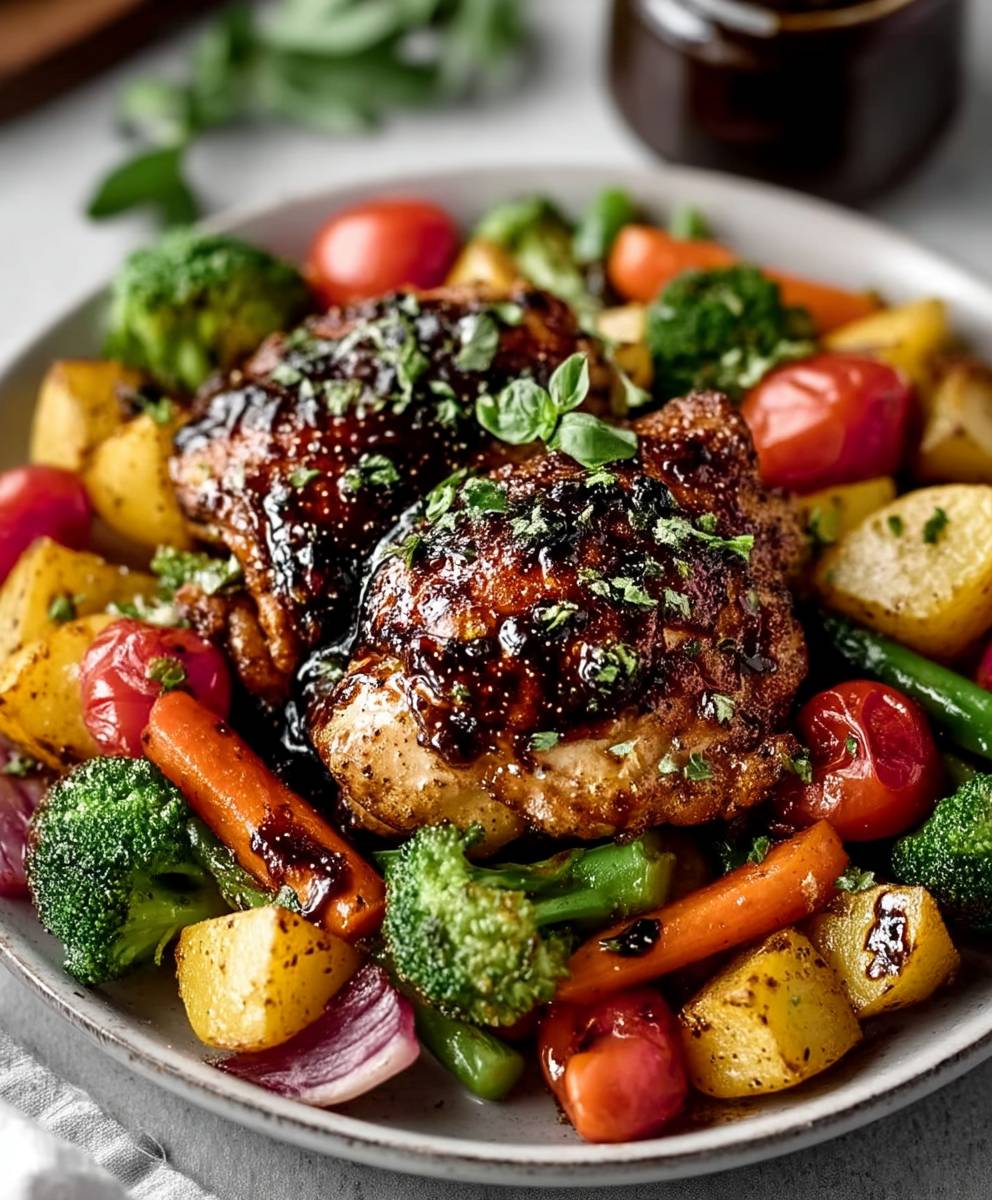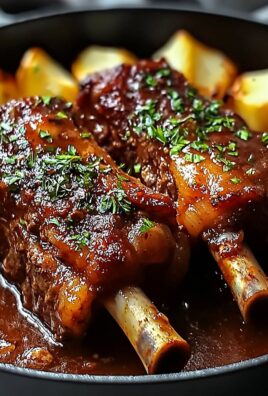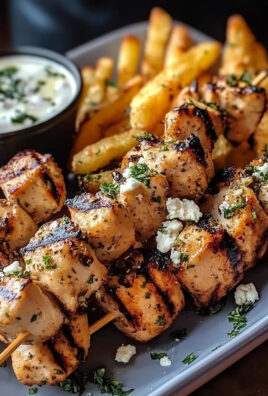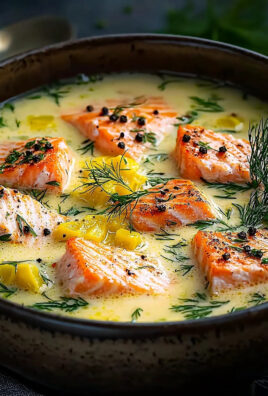Balsamic Glazed Chicken Veggies: Prepare to embark on a culinary adventure that will tantalize your taste buds and leave you craving more! Imagine succulent chicken, perfectly seared and glistening with a rich, tangy-sweet balsamic glaze, nestled amongst a medley of vibrant, roasted vegetables. This isn’t just a meal; it’s an experience.
The beauty of balsamic vinegar stretches back centuries, originating in the Modena and Reggio Emilia regions of Italy. Traditionally aged in wooden barrels, it develops a complex flavor profile that elevates simple dishes to gourmet status. While we might not be using centuries-old balsamic today, we’re certainly channeling that same spirit of culinary excellence!
What makes balsamic glazed chicken veggies so irresistible? It’s the harmonious blend of flavors and textures. The balsamic glaze offers a delightful contrast to the savory chicken and earthy vegetables. People adore this dish because it’s incredibly easy to prepare, making it perfect for busy weeknights, yet elegant enough to serve to guests. The combination of tender chicken, perfectly roasted vegetables, and that unforgettable balsamic tang creates a symphony of flavors that will have everyone asking for seconds. Plus, it’s a relatively healthy and balanced meal, packed with protein and essential nutrients. So, let’s get cooking and create this culinary masterpiece together!
Ingredients:
- For the Chicken:
- 4 boneless, skinless chicken breasts (about 6-8 ounces each)
- 1 tablespoon olive oil
- 1 teaspoon garlic powder
- 1 teaspoon onion powder
- 1/2 teaspoon dried oregano
- 1/2 teaspoon dried basil
- 1/4 teaspoon red pepper flakes (optional, for a little heat)
- Salt and freshly ground black pepper to taste
- For the Balsamic Glaze:
- 1/2 cup balsamic vinegar
- 2 tablespoons honey (or maple syrup for a vegan option)
- 1 tablespoon Dijon mustard
- 1 clove garlic, minced
- For the Roasted Vegetables:
- 1 large red bell pepper, cut into 1-inch pieces
- 1 large yellow bell pepper, cut into 1-inch pieces
- 1 medium red onion, cut into wedges
- 1 zucchini, cut into 1/2-inch thick slices
- 1 yellow squash, cut into 1/2-inch thick slices
- 1 cup broccoli florets
- 1 cup cherry tomatoes, halved
- 2 tablespoons olive oil
- 1 teaspoon Italian seasoning
- Salt and freshly ground black pepper to taste
- Optional Garnishes:
- Fresh parsley, chopped
- Balsamic glaze drizzle (reserved from the glaze recipe)
- Toasted pine nuts or slivered almonds
Preparing the Chicken
- Prepare the Chicken Breasts: First, I like to make sure my chicken breasts are relatively even in thickness. If they’re very thick on one end, you can gently pound them with a meat mallet to about 1/2-inch thickness. This helps them cook evenly and quickly. Don’t overdo it, though; you don’t want to tear the chicken. Pat the chicken breasts dry with paper towels. This is crucial for getting a good sear.
- Season the Chicken: In a small bowl, combine the garlic powder, onion powder, oregano, basil, red pepper flakes (if using), salt, and pepper. Generously sprinkle this mixture over both sides of the chicken breasts, pressing lightly to help the spices adhere. Make sure every part of the chicken is covered for maximum flavor.
- Sear the Chicken: Heat the olive oil in a large skillet over medium-high heat. You want the skillet to be nice and hot before adding the chicken. Once the oil is shimmering, carefully place the seasoned chicken breasts in the skillet, making sure not to overcrowd the pan. If you can’t fit all the chicken in one pan without overcrowding, cook it in batches. Sear the chicken for about 4-5 minutes per side, or until it’s nicely browned and develops a good crust. This searing step is important because it locks in the juices and adds a lot of flavor.
- Finish Cooking the Chicken: After searing, reduce the heat to medium-low, cover the skillet, and continue cooking the chicken for another 5-7 minutes, or until it’s cooked through. The internal temperature should reach 165°F (74°C). You can use a meat thermometer to check for doneness. If the chicken starts to brown too much before it’s cooked through, you can add a tablespoon or two of water or chicken broth to the skillet and continue cooking covered. This will help steam the chicken and keep it moist.
- Rest the Chicken: Once the chicken is cooked through, remove it from the skillet and let it rest for 5-10 minutes before slicing or serving. This allows the juices to redistribute, resulting in a more tender and flavorful chicken.
Making the Balsamic Glaze
- Combine the Ingredients: In a small saucepan, combine the balsamic vinegar, honey (or maple syrup), Dijon mustard, and minced garlic. Whisk everything together until well combined.
- Simmer the Glaze: Place the saucepan over medium heat and bring the mixture to a simmer. Once it’s simmering, reduce the heat to low and let it simmer gently for about 10-15 minutes, or until the glaze has thickened to your desired consistency. It should be thick enough to coat the back of a spoon. Stir occasionally to prevent sticking. Be careful not to overcook the glaze, as it can become too thick and sticky.
- Adjust the Consistency: If the glaze becomes too thick, you can add a tablespoon of water or balsamic vinegar to thin it out. If it’s not thick enough, continue simmering it for a few more minutes.
- Reserve Some Glaze (Optional): If you want to use some of the glaze for drizzling over the finished dish, reserve a tablespoon or two before glazing the chicken.
Roasting the Vegetables
- Preheat the Oven: Preheat your oven to 400°F (200°C).
- Prepare the Vegetables: While the oven is preheating, prepare the vegetables. Wash and chop the bell peppers, red onion, zucchini, yellow squash, broccoli, and cherry tomatoes according to the ingredient list. I like to cut the vegetables into roughly the same size pieces so they cook evenly.
- Toss with Oil and Seasoning: In a large bowl, toss the chopped vegetables with the olive oil, Italian seasoning, salt, and pepper. Make sure all the vegetables are evenly coated with the oil and seasoning.
- Spread on a Baking Sheet: Spread the seasoned vegetables in a single layer on a large baking sheet. If you overcrowd the baking sheet, the vegetables will steam instead of roast, and they won’t get that nice caramelized flavor. If necessary, use two baking sheets.
- Roast the Vegetables: Roast the vegetables in the preheated oven for 20-25 minutes, or until they are tender and slightly browned. Toss the vegetables halfway through the cooking time to ensure even roasting. Keep an eye on them, as cooking times may vary depending on your oven.
Assembling the Dish
- Glaze the Chicken: Once the chicken is cooked and rested, brush it generously with the balsamic glaze. Make sure to coat both sides of the chicken with the glaze. You can also spoon some of the glaze over the chicken.
- Slice the Chicken (Optional): If you prefer, you can slice the chicken breasts before serving. This makes it easier to eat and also allows the glaze to penetrate the chicken more evenly.
- Serve the Dish: Arrange the roasted vegetables on a platter or individual plates. Place the glazed chicken on top of the vegetables.
- Garnish (Optional): Garnish the dish with fresh parsley, a drizzle of reserved balsamic glaze, and toasted pine nuts or slivered almonds, if desired. These garnishes add a pop of color and flavor to the dish.
- Enjoy! Serve immediately and enjoy your delicious Balsamic Glazed Chicken with Roasted Vegetables! This dish is great on its own, but you can also serve it with a side of quinoa, rice, or couscous.
Tips and Variations
- Chicken Thighs: You can substitute boneless, skinless chicken thighs for the chicken breasts. Chicken thighs are more forgiving and tend to stay more moist during cooking.
- Vegetable Variations: Feel free to use any vegetables you like in this recipe. Some other good options include asparagus, Brussels sprouts, carrots, and sweet potatoes.
- Spice Level: Adjust the amount of red pepper flakes to your liking. If you don’t like spicy food, you can omit them altogether.
- Sweetness: Adjust the amount of honey (or maple syrup) in the balsamic glaze to your liking. If you prefer a less sweet glaze, you can reduce the amount of sweetener.
- Marinating the Chicken: For even more flavor, you can marinate the chicken in the balsamic glaze for at least 30 minutes, or up to overnight, before cooking.
- Grilling the Chicken: You can also grill the chicken instead of searing it in a skillet. Grill the chicken over medium heat for about 6-8 minutes per side, or until it’s cooked through. Brush with the balsamic glaze during the last few minutes of grilling.
- Adding Herbs: Fresh herbs like rosemary, thyme, or sage can be added to the roasted vegetables for extra flavor.
- Make it Vegan: To make this recipe vegan, use maple syrup instead of honey in the balsamic glaze and ensure that the Dijon mustard you use is vegan-friendly.
Make-Ahead Tips
- Prepare the Vegetables: You can chop
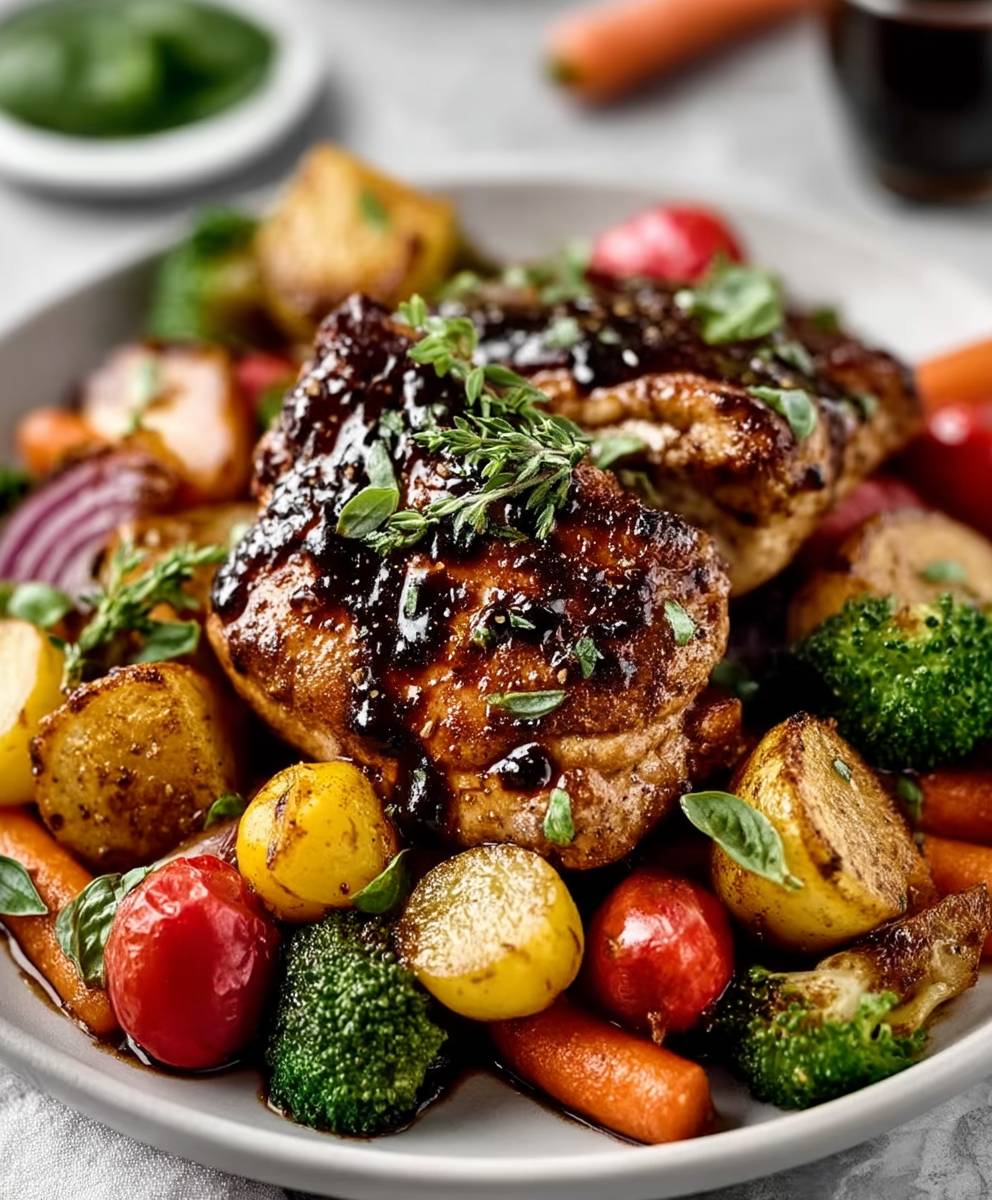
Conclusion:
This Balsamic Glazed Chicken and Veggies recipe is truly a game-changer, and I wholeheartedly believe it deserves a spot in your regular dinner rotation. Why? Because it delivers on all fronts: incredible flavor, ease of preparation, and healthy ingredients. The tangy-sweet balsamic glaze transforms simple chicken and vegetables into a restaurant-worthy meal, all without requiring hours in the kitchen. It’s the kind of dish that makes you feel good about what you’re eating, both inside and out.
But the real magic lies in the simplicity. We’re talking minimal prep time, a single pan for easy cleanup, and readily available ingredients. No fancy techniques or hard-to-find spices are required. This recipe is designed for busy weeknights, when you crave a delicious and satisfying meal but don’t have the time or energy for complicated cooking. It’s also perfect for impressing guests without breaking a sweat. Trust me, the aroma alone will have everyone clamoring for a taste.
Beyond its inherent deliciousness, this recipe is incredibly versatile. Feel free to experiment with different vegetables based on what’s in season or what you have on hand. Asparagus, bell peppers, zucchini, and red onion all work beautifully with the balsamic glaze. For a heartier meal, add some roasted potatoes or sweet potatoes to the mix. And if you’re looking to switch things up, try using bone-in chicken thighs for a richer flavor, or even salmon fillets for a pescatarian option.
Serving suggestions are endless! I love to serve this Balsamic Glazed Chicken and Veggies over a bed of quinoa or brown rice to soak up all that delicious glaze. A simple side salad with a light vinaigrette complements the dish perfectly. You could also shred the chicken and veggies and use them as a filling for tacos or wraps. And for a truly decadent treat, drizzle a little extra balsamic glaze over the top just before serving.
Don’t be afraid to get creative and make this recipe your own. That’s the beauty of cooking it’s all about experimentation and finding what you love. I encourage you to try this recipe as soon as possible. I am confident that you will love it as much as I do. It’s a guaranteed crowd-pleaser that will quickly become a family favorite.
So, what are you waiting for? Gather your ingredients, preheat your oven, and get ready to experience the magic of Balsamic Glazed Chicken and Veggies. I can’t wait to hear what you think! Please, share your experience in the comments below. Let me know what variations you tried, what vegetables you used, and how your family enjoyed it. Your feedback is invaluable and helps me continue to create recipes that you’ll love. Happy cooking!
Balsamic Glazed Chicken Veggies: A Delicious & Easy Recipe
Tender chicken breasts seared and glazed with tangy-sweet balsamic reduction, served with colorful roasted vegetables.
Ingredients
- 4 boneless, skinless chicken breasts (about 6-8 ounces each)
- 1 tablespoon olive oil
- 1 teaspoon garlic powder
- 1 teaspoon onion powder
- 1/2 teaspoon dried oregano
- 1/2 teaspoon dried basil
- 1/4 teaspoon red pepper flakes (optional, for a little heat)
- Salt and freshly ground black pepper to taste
- 1/2 cup balsamic vinegar
- 2 tablespoons honey (or maple syrup for a vegan option)
- 1 tablespoon Dijon mustard
- 1 clove garlic, minced
- 1 large red bell pepper, cut into 1-inch pieces
- 1 large yellow bell pepper, cut into 1-inch pieces
- 1 medium red onion, cut into wedges
- 1 zucchini, cut into 1/2-inch thick slices
- 1 yellow squash, cut into 1/2-inch thick slices
- 1 cup broccoli florets
- 1 cup cherry tomatoes, halved
- 2 tablespoons olive oil
- 1 teaspoon Italian seasoning
- Salt and freshly ground black pepper to taste
- Fresh parsley, chopped
- Balsamic glaze drizzle (reserved from the glaze recipe)
- Toasted pine nuts or slivered almonds
Instructions
- Prepare the Chicken Breasts: Ensure chicken breasts are relatively even in thickness (about 1/2-inch). Pat dry with paper towels.
- Season the Chicken: Combine garlic powder, onion powder, oregano, basil, red pepper flakes (if using), salt, and pepper in a small bowl. Sprinkle generously over both sides of the chicken breasts.
- Sear the Chicken: Heat olive oil in a large skillet over medium-high heat. Sear chicken for 4-5 minutes per side, until browned.
- Finish Cooking the Chicken: Reduce heat to medium-low, cover the skillet, and cook for another 5-7 minutes, or until the internal temperature reaches 165°F (74°C). Rest for 5-10 minutes before slicing.
- Combine Glaze Ingredients: In a small saucepan, combine balsamic vinegar, honey (or maple syrup), Dijon mustard, and minced garlic.
- Simmer the Glaze: Bring to a simmer over medium heat, then reduce heat to low and simmer gently for 10-15 minutes, or until thickened. Stir occasionally.
- Adjust Glaze Consistency: If too thick, add water or balsamic vinegar. If not thick enough, continue simmering. Reserve some for drizzling, if desired.
- Preheat Oven: Preheat oven to 400°F (200°C).
- Prepare Vegetables: Chop bell peppers, red onion, zucchini, yellow squash, broccoli, and cherry tomatoes.
- Toss with Oil and Seasoning: Toss vegetables with olive oil, Italian seasoning, salt, and pepper in a large bowl.
- Spread on Baking Sheet: Spread vegetables in a single layer on a large baking sheet.
- Roast the Vegetables: Roast for 20-25 minutes, or until tender and slightly browned, tossing halfway through.
- Glaze the Chicken: Brush cooked chicken generously with balsamic glaze.
- Slice the Chicken (Optional): Slice chicken breasts before serving, if desired.
- Serve the Dish: Arrange roasted vegetables on a platter or individual plates. Place glazed chicken on top.
- Garnish (Optional): Garnish with fresh parsley, a drizzle of reserved balsamic glaze, and toasted pine nuts or slivered almonds.
Notes
- Chicken Thighs: Substitute boneless, skinless chicken thighs for the chicken breasts.
- Vegetable Variations: Use any vegetables you like.
- Spice Level: Adjust the amount of red pepper flakes to your liking.
- Sweetness: Adjust the amount of honey (or maple syrup) in the balsamic glaze to your liking.
- Marinating the Chicken: Marinate the chicken in the balsamic glaze for at least 30 minutes, or up to overnight, before cooking.
- Grilling the Chicken: Grill the chicken over medium heat for about 6-8 minutes per side, or until it’s cooked through. Brush with the balsamic glaze during the last few minutes of grilling.
- Adding Herbs: Fresh herbs like rosemary, thyme, or sage can be added to the roasted vegetables for extra flavor.
- Make it Vegan: To make this recipe vegan, use maple syrup instead of honey in the balsamic glaze and ensure that the Dijon mustard you use is vegan-friendly.

